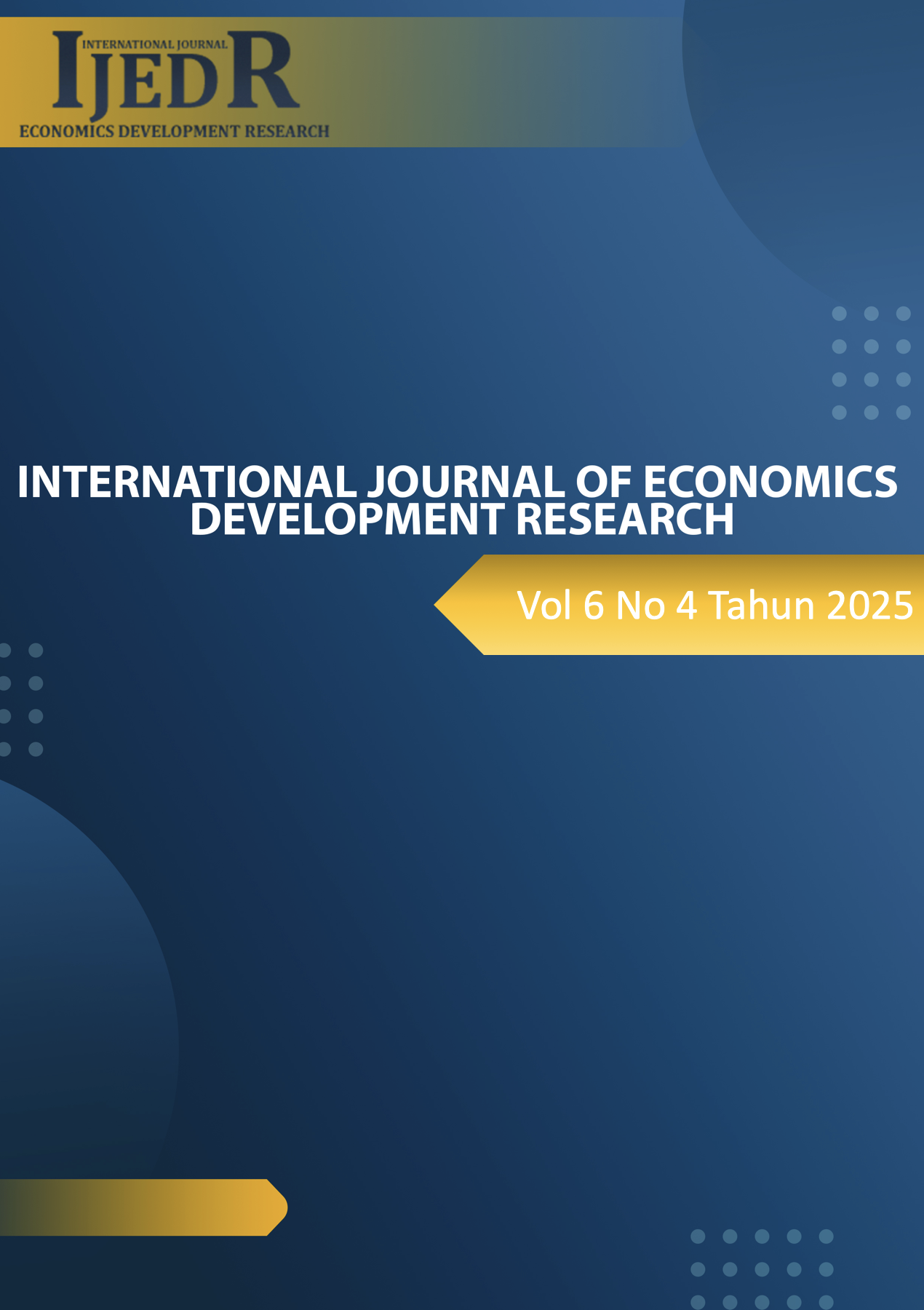Hydrogen Development Strategy for Power Company in Indonesia’s Transportation Sector using Scenario Planning
DOI:
https://doi.org/10.37385/ijedr.v6i6.8230Keywords:
Hydrogen, Power Company, Scenario Planning, Transportation SectorAbstract
One of the initiatives undertaken by Power Company to promote the NZE had been stated in its mid-term planning for 2024-2028 is the implementation of green hydrogen in transportation sector by developing hydrogen refuelling station and establishing the green hydrogen plant (GHP), producing hydrogen with the excess capacity of 124 tons per year. This excess hydrogen has been targeted to be one of revenue resources in beyond kWh, but Power Company had not been established the roadmap. Conversely, the National Roadmap of Hydrogen and Ammonia (RHAN) had been launched by government, targeting 3,690 tons hydrogen utilization per year in transportation sector by 2035 and FECV commercialization stage starting from 2031. The objective of this study is to formulate an appropriate strategy for Power Company in utilizing excess hydrogen in the transportation sector through scenario planning approach. Data are analyzed using PESTLE, Porter’s Five Forces, and semi-structured interview to formulate 2x2 matrix based on the main uncertainties. Four scenarios have been formulated which are called Going Highway, Queueing Tickets, Asking Innovations, and Entering Rest Area as combination of government support and the economic of hydrogen. Shifting to other scenarios should follow the key leading indicators and adjustment to recent working plans need to be done. This study approach can be used as reference for hydrogen producers or policymakers to construct the balanced strategy for hydrogen business development.
References
Aguilera, R. F., & Inchauspe, J. (2022). An overview of hydrogen prospects: Economic, technical and policy considerations. Australian Journal of Agricultural and Resource Economics. John Wiley and Sons Inc. https://doi.org/10.1111/1467-8489.12458
Amer, M., Daim, T. U., & Jetter, A. (2013). A review of scenario planning. Futures, 46, 23–40. https://doi.org/10.1016/j.futures.2012.10.003
Cordova-Pozo, K., & Rouwette, E. A. J. A. (2023). Types of scenario planning and their effectiveness: A review of reviews. Futures. Elsevier Ltd. https://doi.org/10.1016/j.futures.2023.103153
Di Pierro, G., Bitsanis, E., Tansini, A., Bonato, C., Martini, G., & Fontaras, G. (2024). Fuel Cell Electric Vehicle Characterisation under Laboratory and In?use Operation. Energy Reports, 11, 611–623. https://doi.org/10.1016/j.egyr.2023.12.013
Hydrogen Council & McKinsey & Company. (2025). Hydrogen: Closing the cost gap – Unlocking demand for clean hydrogen by 2030. Hydrogen Council. https://hydrogencouncil.com/en/hydrogen-closing-the-cost-gap/
IRENA (2024), Green hydrogen strategy: A guide to design, International Renewable Energy Agency, Abu Dhabi. https://www.irena.org/-/media/Files/IRENA/Agency/Publication/2024/Jul/IRENA_Green_hydrogen_strategy_design_2024.pdf
Kouchaki-Penchah, H., Bahn, O., Bashiri, H., Bedard, S., Bernier, E., Elliot, T., Levasseur, A. (2024). The role of hydrogen in a net-zero emission economy under alternative policy scenarios. International Journal of Hydrogen Energy, 49, 173–187. https://doi.org/10.1016/j.ijhydene.2023.07.196
Len, C. (2025). Green Hydrogen in Southeast Asia: Connecting National Strategies with Public Support. ISEAS Perspective, No. 33. ISEAS – Yusof Ishak Institute. Retrieved from https://www.iseas.edu.sg/wp-content/uploads/2024/08/ISEAS_Perspective_2025_33.pdf
Ling-Chin, J., Giampieri, A., Wilks, M., Lau, S. W., Bacon, E., Sheppard, I., Roskilly, A. P. (2024). Technology roadmap for hydrogen-fuelled transportation in the UK. International Journal of Hydrogen Energy, 52, 705–733. https://doi.org/10.1016/j.ijhydene.2023.04.131
Lu, Q., Zhang, B., Yang, S., & Peng, Z. (2022). Life cycle assessment on energy efficiency of hydrogen fuel cell vehicle in China. Energy, 257. https://doi.org/10.1016/j.energy.2022.124731
Marzouk, O. A. (2024). Expectations for the Role of Hydrogen and Its Derivatives in Different Sectors through Analysis of the Four Energy Scenarios: IEA-STEPS, IEA-NZE, IRENA-PES, and IRENA-1.5°C. Energies, 17(3). https://doi.org/10.3390/en17030646
Ministry of Energy and Mineral Resources of Indonesia. (2022, September 2). Energy Ministry, IEA Launch NZE Roadmap [Press release]. https://www.esdm.go.id/en/media-center/news-archives/luncurkan-peta-jalan-nze-sektor-energi-indonesia-ini-hasil-pemodelan-iea
Ministry of Energy and Mineral Resources. (2024). Handbook of energy and economic statistics of Indonesia 2023. Center for Data and Information Technology on Energy and Mineral Resources. https://www.esdm.go.id/assets/media/content/content-handbook-of-energy-and-economic-statistics-of-indonesia-2023.pdf
Mukelabai, M. D., Wijayantha, K. G. U., & Blanchard, R. E. (2022). Hydrogen technology adoption analysis in Africa using a Doughnut-PESTLE hydrogen model (DPHM). International Journal of Hydrogen Energy, 47(74), 31521–31540. https://doi.org/10.1016/j.ijhydene.2022.07.076
Nnabuife, S. G., Oko, E., Kuang, B., Bello, A., Onwualu, A. P., Oyagha, S., & Whidborne, J. (2023). The prospects of hydrogen in achieving net zero emissions by 2050: A critical review. Sustainable Chemistry for Climate Action, 2. https://doi.org/10.1016/j.scca.2023.100024
Pangarkar, N., & Prabhudesai, R. (2024). Using Porter’s Five Forces analysis to drive strategy. Global Business and Organizational Excellence, 43(5), 24–34. https://doi.org/10.1002/joe.22250
Pepe, J. M., Ansari, D., & Gehrung, R. M. (2023). The geopolitics of hydrogen: technologies, actors, and scenarios until 2040. SWP Research Paper Stiftung Wissenschaft Und Politik (SWP), 1–48.
PLN. (2024b). Journey PLN dalam Pengembangan Hidrogen. Presented in FGD KBLI H2, Double Tree Jakarta by Division of Corporate Business Development and Investment.
Porter, M. E. (1997, February 1). Competitive strategy. Measuring Business Excellence. https://doi.org/10.1108/eb025476
Ramirez, R., & Wilkinson, A. (2014). Rethinking the 2×2 scenario method: Grid or frames? Technological Forecasting and Social Change, 86, 254–264. https://doi.org/10.1016/j.techfore.2013.10.020
Surya Husada, V., & Erar Joesoef, I. (2022). Legal Policy of the Indonesian Government to Achieve Net Zero Emissions. Journal Research of Social Science, Economics, and Management, 2(1). https://doi.org/10.59141/jrssem.v2i1.248
Zhang, Y., & Wildemuth, B. M. (2016). Qualitative content analysis. In B. M. Wildemuth (Ed.), Applications of social research methods to questions in information and library science (2nd ed., pp. 318–329). Libraries Unlimited.





